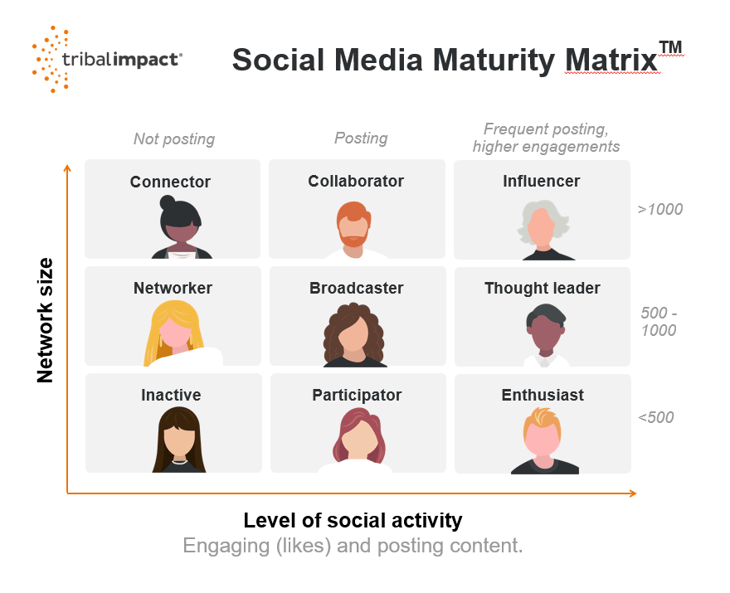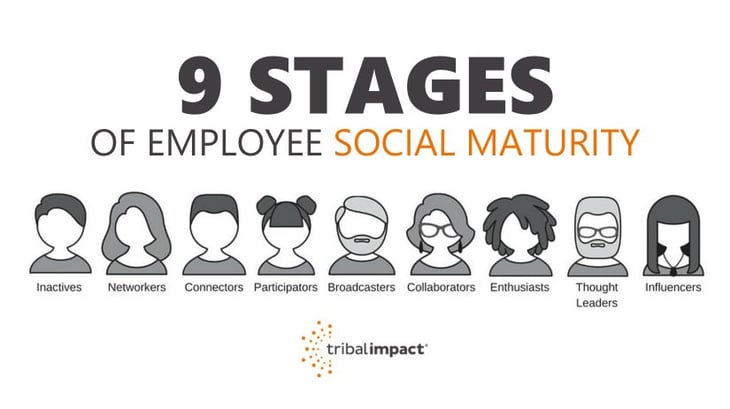Throughout my career, I’ve been fascinated by how people engage with each other in business. I’m always up for trying those personality studies and tests to figure out my business profile and where I best fit into an organisation.
Before I set up Tribal Impact, I trained thousands of employees at SAP to build their personal brand online as part of a huge global effort to shift the organisation to become a socially active business.
During that time, I noticed that employees broadly fell into different categories of social media maturity largely driven by the extent to which they networked and how digitally active they were.
This isn’t a scientific study by any stretch of the imagination nor is it a hard and fast categorisation. It’s a model that we use to map scalable social media activation solutions for our global B2B clients to help them grow their employee branding, leadership advocacy and social selling programmes in a structured way.
The Social Media Maturity Model Explained
The model looks at the extent to which employees network against their level of social activity. When mapping employees to such a model it’s easier to target specific support at audience groups to help them advance – if they so wish!
Generally speaking, the higher you are in the model the more connections you are likely to have and the more active networker you are. Those employees that sit further to the right of the model tend to be more socially active through videos, blogging and engaging with influencers.

Whilst it’s a basic set of axis, it does determine a natural training path of progression for a social employee.
Typically, employees will move through the grid as they progress in their social maturity journey. Most will recognise where they sit from the definitions below (explained in detail later in this article).

The goal is not to get everyone in your business to become an influencer but more to support employees as far as they’re ready and willing to go on their social business journey.
Our online quiz helps to identify who in your company is interested in learning how to be more digital.
This is great for the employer since the most appropriate training can be targeted to the correct group of individuals.
Now I’m going to explore each of the social employee types further:
 |
Inactives:Inactives don’t have much of an online presence. LinkedIn is normally activated only when they’re looking for a new job – it’s considered nothing more than a digital version of their CV. Traits include an incomplete LinkedIn profile, perhaps no photo and a very low number of connections. However, this group may be very active on social networks that would be considered more personal e.g. Facebook and Instagram.
|
 |
Networkers:This group are typically more active on LinkedIn but no other platform other than personal social networks. They will often accept invitations online and may even occasionally send invitations to others. Networkers are more passive on LinkedIn, sometimes finding it easier to network offline than online.
|
 |
Connectors:These folks aren’t just networkers – they’re connectors. You’ll quite often find B2B sales teams here. They have a great network but in the form of business cards sat on their desk and believe in connecting people together because they know that sharing is caring. They don’t have an agenda and they don’t expect anything in return. They just do it because it’s in their nature.
|
 |
Participators:Whilst this group still has a relatively small network, they have typically transferred their business cards to LinkedIn and are testing the water by engaging with others online e.g. liking and commenting on content. They are a group to watch since they are naturally curious but probably don’t have some of the basics in place yet (a good network for example).
|
 |
Broadcasters:Folks in this category are showing more social potential. Perhaps they’ve been “dabbling” for some time by engaging with other people’s content and are now starting to share other people’s content with their network. Many organisations that implement employee advocacy tools serve this space perfectly – employees are provided with “corporate approved” content to share but without contextual training, it can often look like your employees have become another broadcasting channel.
|
 |
Collaborators:As sharers increase their network you tend to see a behavioural change. They broadcast less and appreciate feedback more. Typically, folks in this space have a large network, they’ve been through the engaging and sharing stage and are now starting to formulate opinions themselves and seek to listen to others.
|
 |
Enthusiasts:This group tends to be highly active on social media. Anyone this far right on the model will be actively out there creating their own content and formulating their own opinions. However, they may have a relatively small network. In my experience millennials typically fit this profile, joining the workforce with a strong social acumen but with a limited professional network. Watch this group carefully. Opinionated enthusiasts who aren’t engaged at work can cause issues, while those who are engaged are potentially strong advocates.
|
 |
Thought Leaders:This group tends to be considered the knowledge experts within an organisation e.g. product marketing, pre-sales, sales consultants and they hold an enormous amount of credibility with customers. They don’t actively network (often they don’t have time) but they may blog or video when they can. Enabled and engaged, the group has the potential to set your organisation apart from the competition, by creating content that will attract digital audiences.
|
 |
Influencers:This group consists of highly active networkers and content creators. Social has become part of their daily routine – part of their DNA if you like. They are considered influencers in their field, formulating opinions and writing content that sets them apart and keeps them front of mind. This category of social employee (along with Thought Leaders) will attract customers to your brand online. Make sure these folks are engaged in the company – give them influential opportunities, seek their feedback and promote their content!
|
So there you have it – our 9 categories of employee social maturity. Once you’ve mapped your employees to the maturity model it’s easy to pinpoint the appropriate enablement methods.
At Tribal Impact, we can map all your employees to our Social Media Maturity Matrix™️ to see how digitally active they are today on LinkedIn. We then design role-specific enablement programmes helping them progress on their social media journey.
Our enablement methods come in many forms: from eLearning bite-size modules for beginners, live training, masterclasses, coaching sessions for more advanced users to one-to-one coaching, content creation and strategy support for activating senior leaders on LinkedIn. Our quarterly insights measure your program’s effectiveness, helping you establish the next steps, secure continuous investment and scale your programs quickly.
Hear from one of our customers, Henkel, below on how we helped them through their journey.
